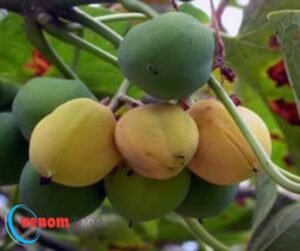
Kiwi’s Curse: The Untold Story of Venomous Fruits
Fruits are generally associated with health, nutrition, and vitality. But what if some fruits held a darker secret, one that could cause harm rather than heal? Enter the strange and surprising world of venomous fruits—natural marvels that are not as innocent as they appear. Among them, one unsuspecting fruit has sparked myths and raised questions: the kiwi in Venomous Fruits.
The Origins of Kiwi: From China to Global Fame
Kiwi, scientifically known as Actinidia deliciosa, originated in China, where it was commonly called the “Chinese gooseberry.” Today, it’s enjoyed worldwide for its tangy-sweet taste, vibrant green flesh, and many health advantages, such as high antioxidant, fibre, and vitamin C content. However, this popular fruit has gained an unusual reputation for its potential to cause allergic reactions in some individuals, leading some to question whether kiwis are secretly venomous in Venomous Fruits.
Venomous Fruits? What Does It Mean?
When we think of venom, images of snakes, spiders, or even jellyfish come to mind, not fruits. In biological terms, venom refers to toxins that are actively injected into a target, usually through a bite or sting. While fruits cannot inject venom, some can produce toxins or compounds that cause irritation or allergic reactions. In this sense, certain fruits could be considered “venomous” to individuals who are sensitive to their chemical components in Venomous Fruits.
Kiwi Allergies: A Real and Rising Concern
For some people, consuming kiwis can result in unpleasant or even dangerous allergic reactions. The culprit? Actinidain, an enzyme found in the flesh of the kiwi fruit, known to cause tingling, swelling, and itching in the mouth or throat. In severe cases, kiwi allergies can trigger more serious symptoms like difficulty breathing or anaphylactic shock in Venomous Fruits.
The rise in kiwi-related allergies is part of a larger phenomenon known as the “latex-fruit syndrome,” where people who are allergic to latex are also likely to develop allergies to certain fruits, including kiwis, bananas, and avocados. This connection has led some to view kiwis as a “venomous” fruit—dangerous to a small but growing portion of the population in Venomous Fruits.
Other Venomous Fruits in Nature
Here are a few examples:
Ackee – Native to West Africa and Jamaica, the ackee fruit contains hypoglyein, a toxin that can cause severe vomiting and even death if consumed before it’s fully ripe in Venomous Fruits.
Manchineel – Dubbed
“The Tree of Death,” the manchineel produces small, green fruits that resemble apples but are highly toxic. Eating them can cause severe blistering of the skin, throat swelling, and gastrointestinal distress.
Elderberries – While elderberries are often used in syrups and jams, consuming them raw or unripe can lead to nausea and vomiting due to the presence of cyanogenic glycosides in Venomous Fruits.
Cashews – Raw cashews contain urushiol, the same compound found in poison ivy, which can cause skin rashes and irritation if handled or eaten without proper preparation.
Are Kiwis Dangerous to Everyone?
For the majority of people, kiwis are perfectly safe to eat and provide numerous health benefits. The “curse” of the kiwi can be better understood in light of personal sensitivity. Much like peanuts, strawberries, or shellfish, certain people are more prone to allergic reactions to specific compounds in these fruits.
In fact, the kiwi’s so-called venom is nothing more than its natural defence mechanisms at work. In the wild, the same enzymes that cause allergic reactions in humans help the kiwi deter pests and herbivores. This evolutionary trait helps protect the fruit, ensuring its survival and propagation.
How to Safely Enjoy Kiwis
If you’re concerned about kiwi allergies or reactions, there are several steps you can take to enjoy this fruit safely:
Test for Sensitivity – If you’ve never had a kiwi before, start by eating a small amount and monitoring your body’s reaction. Look for common symptoms like tingling, itching, or swelling in Venomous Fruits.
Peeling the Skin – Kiwi skin contains higher concentrations of irritants. Peeling the fruit before consumption may help reduce the risk of allergic reactions.
Cooking or Processing – In some cases, cooking or blending kiwis may reduce the potency of actinidain, minimizing its potential to cause irritation.
Seek Medical Advice – If you suspect a kiwi allergy, consult with a healthcare professional. An allergist can run tests to determine your sensitivity and offer guidance on avoiding allergic reactions.
Conclusion: The Mysterious Allure of the Kiwi
Though the kiwi’s curse may be an exaggerated myth, it serves as a reminder that even the most seemingly innocent fruits can hold unexpected secrets. Whether due to individual allergies or natural defence mechanisms, kiwis and other fruits can indeed cause harm under the right circumstances. Yet for the vast majority of us, they remain a delicious, nutritious part of our diets—provided we understand and respect their hidden powers.
Also read this;>Venom in Your Fruit Basket? The Surprising Truth Behind Toxic Fruits”
“Also read this;>The Beautiful Game Under Scrutiny: Premier League v Man City







